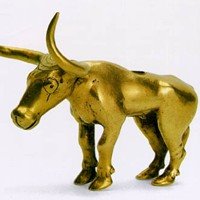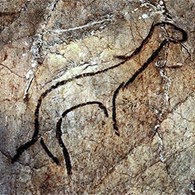10,000
9,500
9,000
8,200
8,000
7,500
7,000
6,000
5,500
5,000
4,000
4,000-2,500
3,500
3,300
3,200
3,200
3,100
2,800
2,700
2,660
2,500
2,100
2,000
2,000-1,500
1,780
1,750
1,700
1,600
1,530-1,500
1,500
1,450
1,425
1,390
1,250
1,200
1,184
1,100
1050-221
900
800
800-700
600 BCE |
MESOLITHIC ERA
BEGINS
This is associated with a wide variety of races, including the Azilian Ofnet
Man (Bavaria); several types of Cro-Magnon Man, brachycephalic humans (short-skulled),
dolichocephalic humans (long-skulled). The Mesolithic is a transitional
era between the chipped-tool, hunter-gatherer culture of the Upper Paleolithic,
and the polished-tool, farming culture of the Neolithic. In areas with no
ice (eg. the Middle East), people transitioned quite rapidly from hunting/gathering
to agriculture. Their Mesolithic period was therefore short, and often referred
to as the Epi-Paleolithic or Epipaleolithic. 10,000 BCE marks the end of
the Pleistocene geological epoch and the start of the Holocene. Start of
Chinese Pottery.
Cueva de las Manos (Cave of
the Hands), stencils, paintings, Argentina, the most famous example
of Mesolithic art in the Americas.
Large finds of Stone Age artifacts at Fell's Cave in Patagonia and Blackwater
Draw in eastern New Mexico (Clovis culture).
Bhimbetka Rock Art, paintings, stencils, abstract symbols, India.
Pachmari Hills: sandstone rock drawings, paintings, India.
Wonderwerk Cave engravings of geometric designs, ideograms, animals, South
Africa.
NEOLITHIC ERA BEGINS IN MIDDLE EAST AND SOUTHEAST EUROPE
Tassili-n-Ajjer rock art, Algerian paintings and petroglyphs.
Ancient Persian pottery from Ganj Dareh (Valley of Treasure). Jiahu turquoise
carvings, bone flutes, Henan Province China.
Shigir Idol, the world's oldest
surviving wood carving of a human figure.
Beginning of Neolithic Art
in China (7000-2000 BCE). The major form of Neolithic
art was ceramic pottery. Oven-fired pottery appears in Mesopotamia where
farming begins.
People settle on the banks of the River Nile.
Coldstream Burial Stone, Western Cape Province, South Africa.
Goddess terracotta figurine, Catal Huyuk, Anatolia, an early example of
religious art.
Egyptian bone, ivory, stone figurines from Naquada I Period.
Persian Chalcolithic pottery.
Linear Ceramic culture emerges in France, Germany, Austria, Slovakia, Czech
Republic.
Thinker of Cernavoda,
the Romanian terracotta sculpture
of the Hamangia culture.
Fish God of Lepenski Vir, sandstone carving of therianthropic figure,
Serbia.
Samarra and Halaf ceramic plates: see: Sumerian
Art and Mesopotamian art (c.4500-539).
NEOLITHIC ERA BEGINS IN NORTHERN & WESTERN EUROPE
Mesolithic Era ends in Europe, superceded by the Neolithic (New Stone Age),
a much more settled form of existence, based on farming and rearing of domesticated
animals, as well as the use of polished tools.
Jade carving begins in China,
as does Chinese lacquerware
and silk production.
Earliest megalithic architecture, like: the megaliths
at Evora, in Portugal (from 5,000); Breton Cairn of Barnenez (from 4,450);
the tombs and monuments of Carrowmore, Cuil Irra Peninsula, Ireland (from
4,300). Building of Stonehenge stone
circle begins (c.2,600 BCE). See also: megalithic
art.
Mesopotamian civilization begins
(Iraq). Emergence of Uruk, first city-state. First wheeled vehicles appear
in Europe. Ancient Persian art includes
the intricate ceramics from Susa and Persepolis. Oldest known prehistoric
bronze sculptures produced in the Maikop culture of the Russian North Caucasus
around 3,500, using simple arsenic bronze process.
Sumerian civilization (S. Iraq). First writing system (hieroglyphs). Cuneiform
script 3200.
Egyptian art and civilization begins.
Building of Newgrange
Megalithic Tomb begins.
Sumerian civilization develops its own monumental architecture - a type
of stepped pyramid called a ziggurat, built from clay-fired bricks.
See History of Architecture.
BRONZE AGE BEGINS IN EUROPE
Metallurgy develops, as does Bronze
Age art. The more complex copper-and-tin bronze casting techniques appear
in the Indus Valley Civilization
of India during the period.
First use of horses for drawing wagons and carts. See: Egyptian
Architecture (3000 on).
First wheeled transport (Sumeria).
Egyptians create first wall paintings in tombs.
Copper-working begins in southern France.
Emergence of Beaker culture in Europe (named after their distinctive drinking
vessels).
Egyptians develop first painted relief sculptures.
Egyptians develop the first seated and free-standing statues.
Start of Egyptian
Pyramids. Djoser's 'Step Pyramid' at Saqqara (2630); the Architect Hemon
designs the Great Pyramid at Giza (2550), one of the Seven
Wonders of the World; Khufu builds the Sphinx (2550). See also Early
Egyptian Architecture (3100-2181).
Dabous Giraffe Engravings, Taureg Saharan culture. Knowth
Megalithic Tomb built.
Valdivia Figurines, First 3-D images of the Americas (Real Alto Ecuador).
Mesopotamian sculpture
known as Ram in a Thicket,
made from gold-leaf, copper, lapis lazuli. Sculptors make Maikop Gold Bull.
Start of Aegean Art in eastern
Mediterranean.
Bronze Dancing Girl of Mohenjo-Daro, Harappan Culture, Indus Valley
Civilization.
Famous Ziggurat constructed in Uruk. Egyptian
Middle Kingdom Architecture (2055-1650).
"X-ray" style of Aboriginal rock art developed in Arnhem Land.
Xia Dynasty culture, China.
Minoan Palaces built & rebuilt on Crete. Outstanding Minoan
artworks: pottery/ceramics.
The written Code of Hammurabi (laws) displayed throughout Babylonian
empire.
First outstanding Chinese art appears,
bronzes of Shang Dynasty art,
as well as the earliest Calligraphy. See:
Traditional Chinese Art:
Characteristics.
Linear A script introduced by Minoans. Start of Hittite
art and Assyrian art of Iraq.
Mycenaean civilisation flourishes in Greece. Glass making perfected in Mesopotamia.
Construction of massive temple complex of Karnak to the god Amon at Thebes.
See also: Egyptian New Kingdom
Architecture (1550-1069).
IRON AGE BEGINS IN EUROPE
Iron Age Art begins in Europe. Meanwhile,
the first bronze sculptures appear in China.
Myceneans invent form of writing based on Minoan Linear B script. See Irish
Iron Age Art.
Myceneans (Greek mainland) absorb Minoans.
Amenhotep III builds the palace at Malkata (near Thebes) and temple of Amon
at Luxor.
Rameses II builds the Colossus at Memphis, the Hypostyle Hall of the Karnak
temple Luxor. Decline of Mycenean civilization.
(Architectural Dark Ages begins. Ends 600.)
Approximate beginning of Pre-Columbian
art in mesoamerica and South America.
Fall of Troy in Asia Minor. In China, Sanxingdui
Bronzes appeared in Sichuan province.
Foundation of the Kingdom of Israel. See also Late
Egyptian Architecture (1069 - 200 CE).
First appearance of Geometric style of Greek
Pottery.
Zhou Dynasty art, the last
period of Bronze Age culture in ancient China.
Earliest settlements appear on Palatine Hill, Rome
Homer writes the Iliad and Odyssey. First Celtic
culture discovered.
Hallstatt
style of art/design begins characterized by geometric designs. After this
comes the elaborate and curvilinear La
Tene style of Celtic
art (450 BCE), with its spirals, zoomorphs and other Celtic
designs.
Hereafter, Greek art and architecture is divided
into three basic eras: the Archaic Period (c.600-500 BCE), the Classical
Period (c.500-323 BCE) and the Hellenistic Period (c.323-27 BCE). Egyptian,
Greek and Etruscan artists greatly influence later Roman
art, as well as Byzantine art. |

